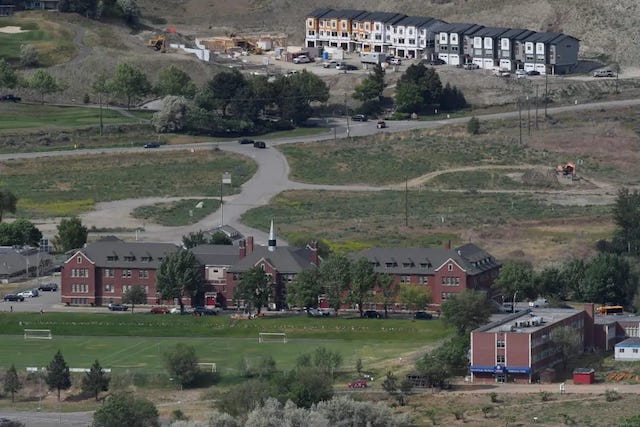Opinion
From mass graves to mass hysteria

The grounds of the former Kamloops Indian Residential School in British Columbia, where some believe Indigenous students may be buried — though there have not been any excavations. – Reuters
The Opposition with Dan Knight
A Canadian Teacher Fired for Challenging the Narrative on Residential Schools—Where’s the Evidence, Where’s the Justice?

|
I am a teacher buffeted daily by the chill winds of political indoctrination, censorship, conformity, and anti-education in schools.
|
The New York Post reported this month that “after two years of horror stories about the alleged mass graves of Indigenous children at residential schools across Canada, a series of recent excavations at suspected sites has turned up no human remains.” In July 2021 the Assembly of First Nations claimed the “mass grave discovered at the former Kamloops Indian Residential School was proof of a “pattern of genocide against Indigenous Peoples that must be thoroughly examined.”
Yet the Canadian government already examined residential schools from 2008-15 through The Truth and Reconciliation Commission, with Commission Chair Murray Sinclair telling the media the number of missing children “could be in the 15-25,000 range, and maybe even more.” To date there has not been a single missing child identified, and not a single document from a parent or chief indicating a child was missing from any of the almost 150 schools over almost 150 years.
I’m not ignorant of the subject of our past as I am informed on the subject of Indian Residential Schools as I am a member of the pan-Canadian Indian Residential Schools Research Group. I also did a Master’s degree in Educational History with specialization in Indian Educational Policy under the supervision of Dr. Robert Carney, who was once the leading expert on the schools. I also obtained a Ph.D. from the University of Toronto where I argued A Case Against Censorship in Literature Education. Professionally, I have taught in high schools, elementary schools, and colleges and was for a time Principal of Neuchâtel Junior College in Switzerland. My last position was in Abbotsford as a senior French Immersion History teacher. It is to Abbotsford that I now turn, for that is where I was fired.
One fateful day in May 2021 I was teaching Calculus 12 at a high school named after the painter Robert Bateman where news was feverishly spread about the discovery of the remains of 215 children in a mass grave at the site of the long-shuttered Kamloops Indian Residential School. The principal used the PA system to ask teachers to stop their regular instruction to navigate the upsetting news with students. In this context, I spoke about the history of residential schools, the dislocation and despair of prairie First Nations (most residential schools being located in the Canadian west), the Indian Act (1876) and its authors’ intentions to support its most marginalized communities, the role of the church as teachers and proselytizers, and the reports of abuse and neglect.
As it was a math class, some of the students were uninterested or bored by my history soliloquy, but one girl spoke up to say the schools represented “cultural genocide.” I agreed with her by saying that modern western schooling was mandatory for indigenous children after 1920, and a third of these children were placed in residential schools (another third attending day schools, and the final third receiving no education at all).
I considered the discussion to be like any other, with some students engaged and others on their phone or quietly doing equations, until a second student, flush with anger and indignancy, reacted to my comment that children who died tragically while enrolled in residential schools did so mostly from disease. She said the Christian teachers in Kamloops (Oblate priests and brothers as well as nuns from the Catholic order The Sisters of St. Ann) were “murderers who tortured students to death by leaving them out in the snow to die.”
I didn’t say anything more, for I feared an argument, and directed students to return to their Calculus work. The class was given a break a few minutes later, and unbeknownst to me the girl complained to a counsellor, who told the principal, who told the district, and before class was over that day, I had a visit from two male administrators who commanded me in front of my students to gather my things and leave. While being frog-marched through the corridor I repeatedly asked what I had done wrong, but they wouldn’t answer. When I was close to the front door I turned to them and said I wouldn’t be leaving without hearing from the principal what I had done. This request was granted, but all the principal would say to me was that it was something I said.
My suspension ended after eight months when the district released its investigator’s report, to which senior management appended a charge of professional misconduct, as the following excerpts show:
“While acting as a TOC for a Calculus 12 class, Mr. McMurtry…inferring [sic] that many of the deaths were due to disease was in opinion inflammatory, inappropriate, insensitive, and contrary to the district’s message of condolences and reconciliation.”
“He left students with the impression some or all of the deaths could be contributed to ‘natural causes’ and that the deaths could not be called murder.”
“Both Mr. McMurtry and student accounts had some students passionately saying the deaths were murder, [and] the graves were mass graves.”
“[We] consider this to be extremely serious professional misconduct.”
While on suspension I dug into the grave story of murdered children and found I was right. Indeed, there was no discovery at all at the residential school in Kamloops in the middle of the Tkʼemlúps te Secwépemc reserve. No graves. No bodies. No murder weapons. No police investigation. No historical record or documentation from a parent or tribal leader of a missing child. Nonetheless, prime minister Justin Trudeau unilaterally ordered that our country lower its flag from coast to coast and in our embassies around the world for over five months, though all that Culture/Media professor Sarah Beaulieu (the sole source of the story) found, using ground-penetrating radar in an abandoned apple orchard on the reserve, were soil anomalies, likely sewage trenches or tiles from 1924. My judgment day was February 21, 2023. The Abbotsford School District trustees had to pronounce on a recommendation for termination from management. That very day I saw that the National Post featured my story on Page 1. I was suddenly under a deluge of support from many media platforms, especially Rebel News which sent a reporter to cover the disciplinary hearing. I boldly predicted in front of supporters that my case was strong and the tide in Canada was turning against cancel culture and its witch hunts, but I was wrong. I was fired and will likely never teach again. Canadian historian Marcel Trudel wrote:
“There is nothing more dangerous than history used as a defense; or history used for preaching; history used as a tool is no longer history.”
I would add that there is nothing more dangerous, in these times, than teaching history truthfully.
In my termination letter this February the case against me changed again, this time it was no longer about what I said but only my “inflammatory, inappropriate, and insensitive tone” that one day two years ago. Then this August I received a letter from the regulatory body for teachers, called the Teaching Regulation Branch (formerly the BC College of Teachers), which changed the case against me again. Now I am accused of “falsely suggesting that student deaths at the schools were comparable to the general child mortality rate and not the result of a government strategy of cultural genocide.” In the same letter the TRB calls for the cancellation of my teaching certificate for life… before my case has arrived at arbitration, before an arbitrator has been chosen or dates have even been set, and long before the merits of my case have been fairly determined.
In Kafka’s play The Trial there is a familiar quotation:
“Someone must have been telling lies about Josef K., he knew he had done nothing wrong but, one morning, he was arrested.”
Subscribe to The Opposition with Dan Knight
I’m an independent Canadian journalist exposing corruption, delivering unfiltered truths and untold stories. Join me on Substack for fearless reporting that goes beyond headlines
Business
The EU Insists Its X Fine Isn’t About Censorship. Here’s Why It Is.

Europe calls it transparency, but it looks a lot like teaching the internet who’s allowed to speak.
|
When the European Commission fined X €120 million on December 5, officials could not have been clearer. This, they said, was not about censorship. It was just about “transparency.”
They repeat it so often you start to wonder why.
The fine marks the first major enforcement of the Digital Services Act, Europe’s new censorship-driven internet rulebook.
It was sold as a consumer protection measure, designed to make online platforms safer and more accountable, and included a whole list of censorship requirements, fining platforms that don’t comply.
The Commission charged X with three violations: the paid blue checkmark system, the lack of advertising data, and restricted data access for researchers.
None of these touches direct content censorship. But all of them shape visibility, credibility, and surveillance, just in more polite language.
Musk’s decision to turn blue checks into a subscription feature ended the old system where establishment figures, journalists, politicians, and legacy celebrities got verification.
The EU called Musk’s decision “deceptive design.” The old version, apparently, was honesty itself. Before, a blue badge meant you were important. After, it meant you paid. Brussels prefers the former, where approved institutions get algorithmic priority, and the rest of the population stays in the queue.
The new system threatened that hierarchy. Now, anyone could buy verification, diluting the aura of authority once reserved for anointed voices.
Reclaim The Net is sustained by its readers.
Your support fuels the fight for privacy, free speech and digital civil liberties while giving you access to exclusive content, practical how to guides, premium features and deeper dives into freedom-focused tech.
Become a supporter here.
However, that’s not the full story. Under the old Twitter system, verification was sold as a public service, but in reality it worked more like a back-room favor and a status purchase.
The main application process was shut down in 2010, so unless you were already famous, the only way to get a blue check was to spend enough money on advertising or to be important enough to trigger impersonation problems.
Ad Age reported that advertisers who spent at least fifteen thousand dollars over three months could get verified, and Twitter sales reps told clients the same thing. That meant verification was effectively a perk reserved for major media brands, public figures, and anyone willing to pay. It was a symbol of influence rationed through informal criteria and private deals, creating a hierarchy shaped by cronyism rather than transparency.
Under the new X rules, everyone is on a level playing field.
Government officials and agencies now sport gray badges, symbols of credibility that can’t be purchased. These are the state’s chosen voices, publicly marked as incorruptible. To the EU, that should be a safeguard.
The second and third violations show how “transparency” doubles as a surveillance mechanism. X was fined for limiting access to advertising data and for restricting researchers from scraping platform content. Regulators called that obstruction. Musk called it refusing to feed the censorship machine.
The EU’s preferred researchers aren’t neutral archivists. Many have been documented coordinating with governments, NGOs, and “fact-checking” networks that flagged political content for takedown during previous election cycles.
They call it “fighting disinformation.” Critics call it outsourcing censorship pressure to academics.
Under the DSA, these same groups now have the legal right to demand data from platforms like X to study “systemic risks,” a phrase broad enough to include whatever speech bureaucrats find undesirable this month.
The result is a permanent state of observation where every algorithmic change, viral post, or trending topic becomes a potential regulatory case.
The advertising issue completes the loop. Brussels says it wants ad libraries to be fully searchable so users can see who’s paying for what. It gives regulators and activists a live feed of messaging, ready for pressure campaigns.
The DSA doesn’t delete ads; it just makes it easier for someone else to demand they be deleted.
That’s how this form of censorship works: not through bans, but through endless exposure to scrutiny until platforms remove the risk voluntarily.
The Commission insists, again and again, that the fine has “nothing to do with content.”
That may be true on a direct level, but the rules shape content all the same. When governments decide who counts as authentic, who qualifies as a researcher, and how visibility gets distributed, speech control doesn’t need to be explicit. It’s baked into the system.
Brussels calls it user protection. Musk calls it punishment for disobedience. This particular DSA fine isn’t about what you can say, it’s about who’s allowed to be heard saying it.
TikTok escaped similar scrutiny by promising to comply. X didn’t, and that’s the difference. The EU prefers companies that surrender before the hearing. When they don’t, “transparency” becomes the pretext for a financial hammer.
The €120 million fine is small by tech standards, but symbolically it’s huge.
It tells every platform that “noncompliance” means questioning the structure of speech the EU has already defined as safe.
In the official language of Brussels, this is a regulation. But it’s managed discourse, control through design, moderation through paperwork, censorship through transparency.
And the louder they insist it isn’t, the clearer it becomes that it is.
|
|
|
|
Reclaim The Net Needs Your
With your help, we can do more than hold the line. We can push back. We can expose censorship, highlight surveillance overreach, and amplify the voices of those being silenced.
If you have found value in our work, please consider becoming a supporter.
Your support does more than keep us independent. It also gives you access to exclusive content, deep dive exploration of freedom focused technology, member-only features, and practical how-to posts that help you protect your rights in the real world.
You help us expand our reach, educate more people, and continue this fight.
Please become a supporter today.
Thank you for your support.
|
Bruce Dowbiggin
Wayne Gretzky’s Terrible, Awful Week.. And Soccer/ Football.

Inquiring minds want to know: Why did FIFA (Federation of International Fraud Artists) award American president Donald Trump a new “Peace Prize” at the Washington D.C. draw for the June/ July tournament? The usual suspects are paralyzed with rage. Everyone else is laughing at the kabuki theatre stunt.
The short answer is that if you were FIFA and you were receiving a reported billion or more dollars from the U.S. and the Canadian/ Mexican cities hosting the 48-team tournament you’d give the host more than a bottle of wine and flowers as a thank-you. Thus the ugly statue and the Boy Scout medal. The obsequious awarding of the prize and match medal were proportionate to the greed of FIFA in extorting the cash.
(America’s fainting goat media immediately complained about unearned awards for little virtue, forgetting as usual that the Nobel folks gave Barack Obama a Peace Prize after nine months in the White House for simply being a black man.)
Trump getting a peace award from FIFA, the most corrupt sports body in the sports world, is mint, however. You can’t write this stuff. (They should give it to him on a speed boat heading across the Caribbean.) The Donald then playfully suggested that Americans leave the name football to the soccer folks because, you know… feet and a ball. More outrage from NFL fans.
So what was the gift for the two Canadian cities hosting games who have also coughed up plenty? Toronto says its estimated budget is $380 million for six games/ B.C. tax payers are obliged to cough up an estimated $580 million for Vancouver’s five games). For cities with, how shall we say, bigger fish to fry.
Sadly all they got was a little farce in which a delighted PM Mark Carney was allowed to Canada as the first ball to start the picking, evidently unaware that all the balls he had to select from also said Canada. Carney’s joy was tempered when he saw Mexican president Claudia Sheinbaum draw a ball that said “Mexico” while Trump— in on the fix— got one entitled “United States”.

In a final attempt to curry favour with the fleeced nations FIFA boss Gianni Infantino gathered the world leaders for a painful onstage selfie, marking the first time Trump and Sheinbaum had ever met in the (orangey) flesh. Call it National Lampoon’s Soccer Vacation.
Having exhausted itself with the peace prize falderol FIFA evidently forgot to put any more thought into the rest of the 55-minute run-up to the draw. While soccer/ footie fans around the world ground their teeth in impatience the organizers presented a combination Eurovision/ People’s choice Awards ordeal of failed cues, untranslated interviews (the Spanish translator showed up about 30 minutes late) and pregnant pauses.
Host Heidi Klum’s stunning gold dress nearly made up for her wooden repartee with comedian Kevin Hart (“not sure why I’m here”) and co-host Rio Ferdinand, former star English defender who, alas, never won the WC. But that was all an appetizer for the real low point, the introduction of global brand stars to pick the draw. NFL legend Tom Brady, NBA legend Shaquille O’Neal and NHL… er, player Wayne Gretzky.
Their task, hectored by the hosts, was to draw a ball, unscrew the thing, withdraw a nation’s name and so on. While there may have been some tension in the audience there was no appreciation of that on the screen as more clunking dialogue and curious pronunciations (Ferdinand kept referring to Group “Haitch”) landed dead on the floor.
The nadir of the ceremony—indeed of his career— was Gretzky’s contribution. Brady and O’Neal had managed to survive their task of unscrewing the ball and pronouncing a name, but Gretzky was brought low by the stage business of the balls and the nations he was forced to announce.

The clearly flustered Gretz (he insisted he’d practiced all morning) wrestled manfully with the balls. Finally the producers went with a long shot of him fumbling in the dark. Then he topped that. Gretzy apparently thinks there are countries called “North Mack-a-donia” and “Cur-ack-ow.” Other stabs at geography were almost as tortured.
Bitter Canadians could put up with him sucking up to Trump (he was mentioned as being in the crowd at the DC Xmas tree lighting) but failing geography is unforgivable. The week that started with Gretzky in a photo golfing at POTUS’s Jupiter, Florida, golf course was ending with him pummelled for his abuse of nations with different-sounding names. The Wayne Gretzky Center For Kids Who Want To Talk Good.
The moral: Never send a centre to do a netminder’s job. Makes you understand why Bobby Orr has laid low since his Trump endorsement came out.
With that bracing date with immortality disposed of the draw proceeded. We had been pounded for an hour about how great the tournament was, and finally footy fans got what they wanted. As a host Canada got a bye into the field. Their reward is playing the tenacious Swiss and, gulp, probably Italy, which is forced to qualify after playing with their food for too long. (Insert your Stanley Tucci joke.)
If not Italy then one of Wales, Bosnia and Herzegovina or Northern Ireland. Oh, right Qatar is in there too as fodder. Been nice knowing you, Canada. The Americans somehow drew a creme puff quartet of Australia, Paraguay and Slovakia, Kosovo, Turkey or Romania. Money can’t buy you love, but it can get you a warm hug from FIFA.
In the end it’ll be one of Brazil, Argentina, Germany or France for the final in the NJ Meadowlands on July 19. Maybe they’ll have a spelling bee at halftime. Or maybe they’ll bring back Trump for the final game to give him another peace prize. Just don’t ask Gretzky to announce Lothar Matthaus, Bruno Guimaräes or Gabriel Magalhäes.
Bruce Dowbiggin @dowbboy is the editor of Not The Public Broadcaster A two-time winner of the Gemini Award as Canada’s top television sports broadcaster, his new book Deal With It: The Trades That Stunned The NHL And Changed hockey is now available on Amazon. Inexact Science: The Six Most Compelling Draft Years In NHL History, his previous book with his son Evan, was voted the seventh-best professional hockey book of all time by bookauthority.org . His 2004 book Money Players was voted sixth best on the same list, and is available via brucedowbigginbooks.ca.
-

 MAiD1 day ago
MAiD1 day agoFrom Exception to Routine. Why Canada’s State-Assisted Suicide Regime Demands a Human-Rights Review
-

 Automotive2 days ago
Automotive2 days agoPower Struggle: Governments start quietly backing away from EV mandates
-

 Business1 day ago
Business1 day agoCarney government should privatize airports—then open airline industry to competition
-

 Business2 days ago
Business2 days agoNew Chevy ad celebrates marriage, raising children
-

 Business1 day ago
Business1 day agoWhat’s Going On With Global Affairs Canada and Their $392 Million Spending Trip to Brazil?
-

 Censorship Industrial Complex2 days ago
Censorship Industrial Complex2 days agoA Democracy That Can’t Take A Joke Won’t Tolerate Dissent
-

 Energy1 day ago
Energy1 day agoCanada following Europe’s stumble by ignoring energy reality
-

 Censorship Industrial Complex2 days ago
Censorship Industrial Complex2 days agoFrances Widdowson’s Arrest Should Alarm Every Canadian







